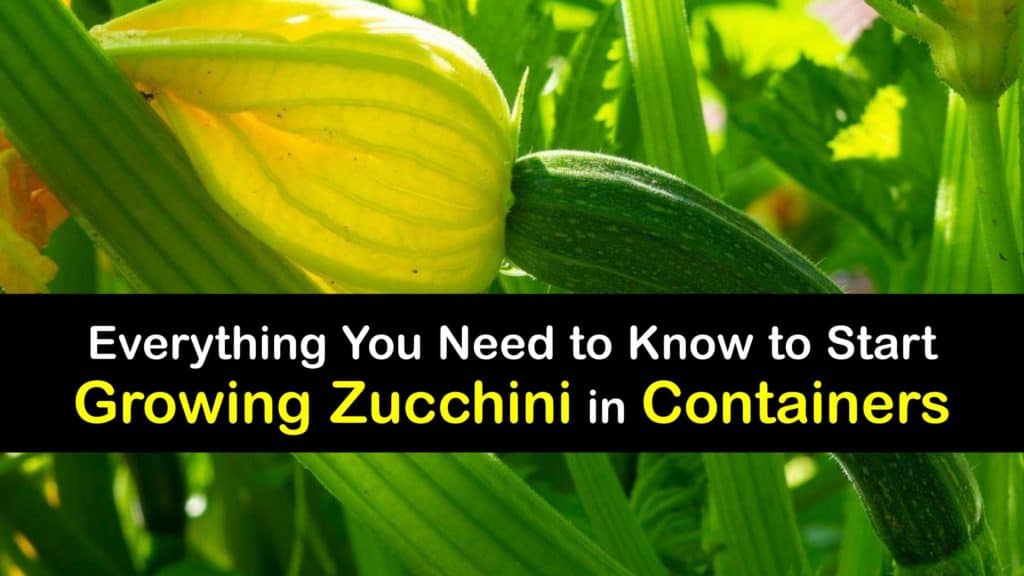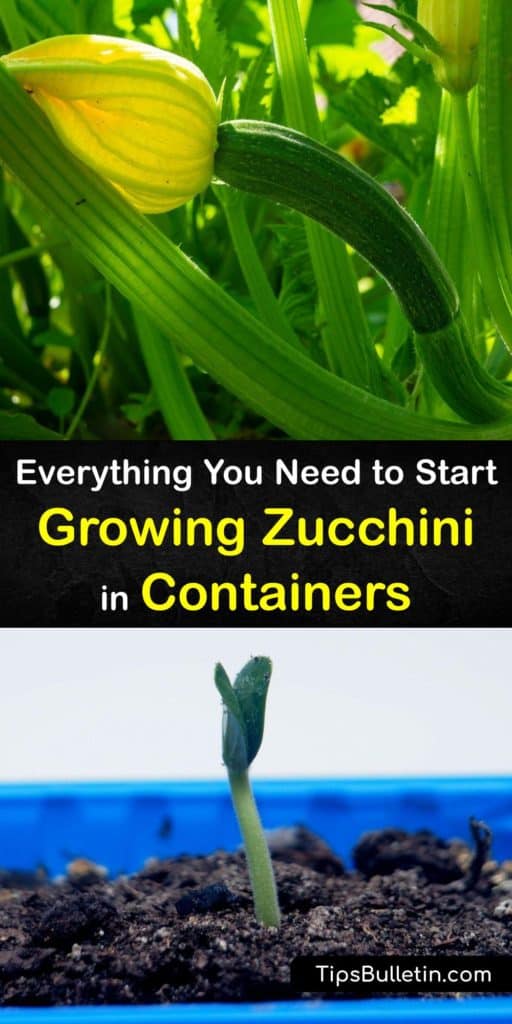Courgette or zucchini is a summer squash that grows ideally in a garden because it requires lots of room for its sprawling growth. Growing zucchini in a container along with other vegetables to grow inside is a unique solution for growing vegetables in pots without much garden space. Learn how to grow zucchini in a container to add this summer squash to your garden while avoiding common issues like soil-borne diseases.
Zucchini is a great source of vitamin A and potassium and is actually classified as a berry, though we cook them as a vegetable. In the kitchen, zucchini are commonly treated like many other vegetables and grilled or steamed before being eaten. Zucchini are also spiraled into noodles for pasta or baked into bread and cakes for dessert.
In most growing zones, summertime is the best time to start growing zucchini since it is a warm-season plant. For gardeners living in warmer areas of the country, sowing seeds in spring and fall is possible. However, controlling where your zucchini plants grow gives you more freedom during the growing season with container gardening.

Growing Zucchini in Containers
We split zucchini varieties into either bush or vining types based on their growth pattern. Bush types grow wide and low to the ground compared to vining varieties. Although both are viable options when wondering how to grow zucchini in containers, the choice depends on the space available in your container garden. Planting squash in containers takes a little planning to ensure you have the proper environment for them to thrive.
Growing Zucchini Indoors
Growing zucchini in containers offers the freedom to choose where your plants grow. While growing zucchini indoors comes with many benefits, there are disadvantages to keeping your plants inside all the time. If you live in a small space, creating room for your growing plants and any support you add may be a challenge.
Common pests like squash bugs, cucumber beetles, gray bugs on zucchini plants, and vine borers can’t target your plants while they grow safely indoors, but neither can beneficial insects. As your plant grows, it first produces male flowers, followed by smaller female flowers.
Luckily, you don’t need a ton of zucchini plants to create a yield, but you do need the help of pollinators like bees, just like when growing gourds and pumpkins in 5 gallon buckets. When you bring your zucchini plants outside, consider covering them with row covers to protect them from pests, avoid using harsh pesticides, and remove them as the flowers bloom.

To improve protection from unwelcome bugs when planting zucchini in pots, consider adding companion plants like nasturtium nearby. Nasturtium is effective at repelling squash bugs, many beetles, and aphids.
Although you can grow vining varieties of zucchini in your home, explore bush varieties for their compact growth pattern. Many come with important resistance to diseases that make growing them straightforward.
Emerald Delight is a bush type zucchini developed to grow in a more compact but open growing pattern, making harvesting zucchini simple as the vegetables are easy to spot. These zucchini are also the fastest to grow, maturing at around 55 days, about one week sooner than most other varieties.
Emerald Delight is also resistant to white mildew on zucchini plant leaves, also known as powdery mildew, a common fungal disease that develops white mold on plant leaves.
Eight Ball zucchini looks like a dark green pumpkin and is an excellent choice for growing in large containers. Eight Ball zucchini mature in about 40 days from hybrid seeds and are easy to pick due to their size and shape.
Astia is a bush type zucchini plant from France that grows compact non-rambling vines and ornamental leaves. It is an excellent choice if you’re looking for a huge harvest as this plant produces an abundance of zucchini near the base of the plant.
Cube of Butter zucchini is bright yellow with a buttery flavor once cooked. This variety is loved for its productive nature, allowing for a continuous harvest. Cube of Butter is resistant to downy mildew and zucchini mosaic virus.
Planting Zucchini Seeds
Select a container that is at least 24 inches wide and 13 inches deep to start growing zucchini in a container, whether you plan to keep them there or will plant zucchini seedlings in the garden later. A plastic bin or wooden crate works if you want to start growing zucchini in containers but don’t have clay pots. If your pot doesn’t have them already, drill or cut drainage holes into the bottom to allow water to drain.
Unlike zucchini grown in the ground, you have complete control over the medium these veggies grow in when planting zucchini in containers. Choose well-draining potting soil with ingredients like peat moss, vermiculite, or perlite for container plants.
Avoid gathering soil from the garden to use in your potting mix as it becomes compacted in containers and may make it difficult for the plant’s roots to expand and grow.
If you’re relying on ambient temperature to help your zucchini plant grow, the best time to plant zucchini indoors is to sow seeds into your container two weeks following the last frost date for your area. Zucchini seeds require temperatures between 65 and 70°F to germinate and grow.
Plant three seeds into the center of the container about an inch deep, leaving a few inches of space between each seed. Cover the seeds and water to keep the soil moist until your seeds germinate in roughly a week.
How to Grow Zucchini in a Container
When you start growing zucchini in containers, as your seeds sprout, remove the weakest sprouts to leave one with a set of true leaves in the pot. Regularly water your plant to moisten the top two inches of soil.
Zucchini are warm-season crops and thrive when grown in full sun, a minimum of six hours of sunlight each day. Due to the size of zucchini plants, leaving them by a window may be the best option if you want to keep your plants indoors, but as they grow, you may want to create space outdoors for your container garden to ensure they are getting enough sun.
Any plants grown in containers lose water faster than they would if you were growing them in garden soil. If you find that the soil around your zucchini plants is becoming dry quickly, consider adding a mulch made of organic matter around the plant to help retain moisture. Using a drip irrigation system provides your plants with adequate water.
As your plant grows, provide it with additional nutrition by feeding it with a water-soluble fertilizer. If you prefer not to apply fertilizer regularly while your plant grows, consider fertilizing using a time-release fertilizer when you first add the potting mix to your container.
Regular moisture and proper nutrition are essential for your plant’s overall health, and they help avoid blossom end rot. Unlike common diseases from a fungal or bacteria source, environmental factors cause blossom end rot.
Extreme changes in soil moisture and calcium deficiency are two contributing factors that are avoided by watering and fertilizing your plant.
For a vining type of zucchini plant, add a trellis to support the weight of your plant’s vines. When growing outdoors and you have a trellis available, aid your plants by guiding the vines around the support beams. Tomato cages make good support for zucchini plants, but making your own support system is easy with a few simple items.
Stick three or four posts in the ground around your pot or use the posts directly in the container. To avoid damaging your plant’s roots, establish your support early in the plant’s growth.
Wrap chicken wire around the wood to create netting and secure the wire with wood staples or nails. Guide your plant’s vines to grab the wire or tie parts of the plant in place as it grows.
If you love zucchini, you’ll love growing your own fresh produce to bring to the kitchen table. With the right equipment, you don’t have to wait for temperatures to warm to start sowing your zucchini seeds, and in no time, you’ll have fresh homegrown veggies to prepare for dinner.

If our guide on how to grow zucchini in a container was helpful to you, please share our tips for growing zucchini indoors with your family on Facebook and Pinterest.